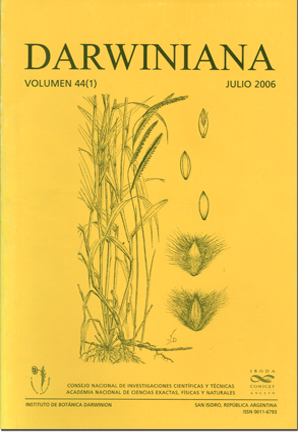Más allá de la taxonomía: perspectivas para entender la diversidad morfológica en la familia de las Gramíneas (Poaceae)
DOI:
https://doi.org/10.14522/darwiniana.2014.441.118Palabras clave:
Poaceae, filogenia, taxonomía, desarrollo, genética cuantitativa, expresión de genesResumen
La familia de las Gramíneas (Poaceae) es bien conocida desde el punto de vista taxonómico, con más de 10.000 especies descriptas, caracterizadas y clasificadas de acuerdo con una variedad de caracteres morfológicos, en particular de la inflorescencia y de la espiguilla, como también por una grancantidad de caracteres micromorfológicos y moleculares. Información abundante sobre esta familia es accesible electrónicamente. Las filogenias disponibles han identificado 12 linajes principales clasificados como subfamilias, dentro de cada una de ellas, y en particular dentro de la subfamilia Panicoideae, la filogenia se está revelando con creciente claridad. Los estudios de desarrollo se enfocan en la
actividad y el destino de los meristemas de toda la planta, e ilustran cómo se origina la morfología adulta. Los análisis de loci de caracteres cuantitativos (QTL) verifican que algunos caracteres taxonómicos son controlados por genes diferentes, apoyando el uso de estos caracteres en la taxonomía. Los
estudios de expresión génica identifican varios genes, entre ellos LEAFY HULL STERILE1, RAMOSA1, y TEOSINTE BRANCHED1, que pueden haber contribuido a la diversificación de las gramíneas.
Descargas
Publicado
31-07-2006
Cómo citar
Kellogg, E. A. (2006). Más allá de la taxonomía: perspectivas para entender la diversidad morfológica en la familia de las Gramíneas (Poaceae). Darwiniana, Nueva Serie, 44(1), 7–17. https://doi.org/10.14522/darwiniana.2014.441.118
Número
Sección
Artículo Invitado
Licencia

A partir de 2012, esta obra está licenciada bajo una Licencia Creative Commons Atribución-NoComercial 2.5 Argentina .
Cualquier obra derivada deberá estar previamente autorizada con nota escrita de los editores.







